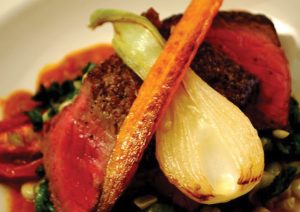
By Paul Suplee,
MBA, CEC, PC-3
One of the most frustrating parts of being a chef is finding that beautiful “Lesser Cut” of meat that no one knows about yet, and then all of a sudden everyone knows about it.
In the past, it was the Teres Major or beef clod, a cut isolated from the chuck that had all the flavor of this divine stewing chunk, but with all the tenderness of a filet mignon.
When it hit the industry around 2002, we could buy if for around $2.95/pound, making it a profitable addition to the menu.
Then, some food network started touting its wonderful flavors and properties, and the next thing we knew, it was $7.95/pound.
The same thing could be said for flank steak after WWII.
With our boys and girls returning home from war, there was a boom in the housing market, with mortgages becoming readily available for GIs. And, in every backyard was a grill. And on every grill was a flank steak.
Well, that was at least until demand far outweighed demand. You see, just like the Teres Major, there are only two flanks on a 1,400-pound steer. This limited cut paired with its popularity raised the bar and, consequently, the price.
And now we have Picanha, hands down my favorite cut of meat to grill and serve. This comes from the sirloin cap, or coulotte in butcher’s terms.
A fat-laden cut, it has tremendous flavor, and if treated properly, it is tender as can be. When I cook mine, I like to skewer it as you would find at Brazilian steakhouses — you know the ones where they walk around with swords of meat?
Yes, those steakhouses, and they are using picanha. As you cut the steak with the grain initially, and curl it to skewer it, you are keeping the meat fibers stretched as they cook, and when you finally slice the meat against the grain, it will be almost as tender as a tenderloin, but with a great deal more flavor.
And the price? Well, it was affordable, but because of rising popularity, it is now becoming the next prized cut to obtain.
While it was only available to wholesale accounts a mere year ago, it is now becoming much more available to the public in grocery stores. And so it goes.
For this dish, I serve it on a vegetable stew of sorts. My brother taught me years ago to buy as much sweet corn as I wanted to deal with in the summertime, and then remove the kernels and freeze them to use all winter long.
It is a mighty fine trick, as nothing replicates that sweet corn flavor. Cooked down with a nice wine and stock combination, there are a great many flavors at work in this composition.
A favorite vegetable of mine to serve here is the Mexican BBQ Onion. You can find them in most local Latin markets, and their flavor is somewhere in between a scallion and a white onion.
First seared, and then roasted to finish, there is a sweetness that lends itself well to the dish.
This cut of beef is a standard on my wedding menus. I have served it to thousands of guests and I doubt I will ever stop serving it. And as much as I shouldn’t share this with you, you should add it to your repertoire this summer or now if you are grilling already.
And now the price just went up two dollars a pound. Oh, the things I do for my readers.
Picanha, Roasted Vegetables
serves 4
4 ea. 6 oz. Picanha steaks
1 stick butter, clarified
Trimix or Steak seasoning, as needed
2 ea. Large Mexican BBQ onions, halved
4 ea. Medium carrots, peeled and halved
2 ea. Roma tomatoes
2 c. Fresh kale, cleaned and ribs removed
1/4 c. Fresh or freshly frozen corn kernels
1/2 c. Fava beans, peeled
1/2 c. Red wine
1/2 c. Good veal or beef stock
• It is probably easier to pull up a video on how to properly prepare a picanha, but I’ll do my best.
• Trim the fat cap to ¼-inch and then cut the steaks 2 inches thick with the grain. It is critical that it is with the grain at this point.
• Curl the steaks into a U so that you can spear them at the ends with a heavy-duty metal skewer. This stretches the muscle fibers as the meat cooks, and that it what keeps it tender at the end.
• To finish, simply brush the steaks with the butter, season and grill to the temperature of your liking (rare to medium rare).
• Allow steaks to rest for at least five minutes.
• Now is when you will slice the steak against the grain. At the end of the day, you will have the most tender of tender sirloin.
• For the vegetables, Get a pan hot and sear the carrots and BBQ onions. Remove to a baking sheet and finish in the oven until tender.
• In the same pan, add the Roma tomatoes, kale, corn, fava beans, wine and reduce by half.
• Add the stock and reduce all down to a nice glace or syrupy consistency.
• Season to taste and serve the steak atop the vegetable “stew” and then top the steak with the carrot and onion. And Bob’s your uncle.
—Paul Suplee is a Professor
of Culinary Arts at Wor-Wic
Community College and owner of
boxcar40 and boxcar on main.
Visit him at www.boxcar40.com;
www.boxcaronmain.com
